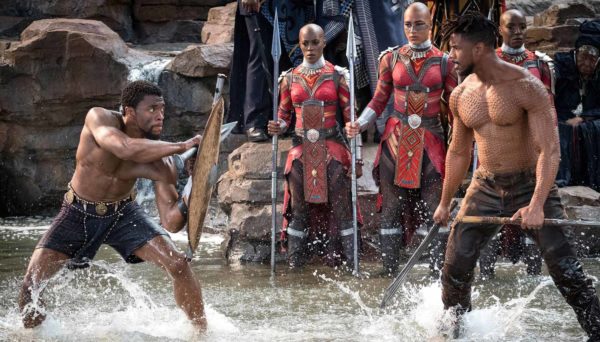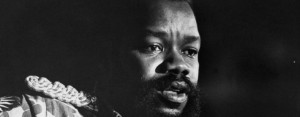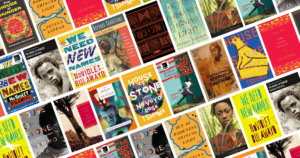
Namwali Serpell has joined the growing number of thinkers and observers who are weighing in on the Black Panther phenomenon. While most think-pieces see the film through its politics or fashion or overall aesthetics, Serpell has particularized hers to something essential in not only Wakanda but in every superhero world: weapons. The essay, in the New York Review of Books, is titled “Black Panther: Choose Your Weapons.”

Here is an excerpt.
*
Weapons are metaphors. We use them in figures of speech (the pen is mightier than the sword) and as figures of speech (stick to your guns). The weapon-as-metaphor suffuses contemporary culture but it is perhaps nowhere more present than in the Marvel Universe. Thor’s boomerang hammer, Spider-Man’s sticky tech—they’re ripe with symbolism. In the franchise’s new blockbuster movie, Black Panther, Ulysses Klaue, a South African arms dealer with a missing arm, unzips his pants in the middle of a South Korean casino and pulls out a hefty curved slab covered in brown paper. It’s labeled “FRAGILE.” He slams it on a table and smirks. It is a joke so old that one of the earliest etymological variants of the word “weapon,” the Old English “wæpnan,” also meant “penis.”
Klaue’s phallo-weapon is the detached head of a pickaxe made of vibranium, the precious metal and major resource of the African Kingdom of Wakanda. It’s unclear whether the original item was a tool or a weapon, used for mining or murder—not that there’s much of a difference to Klaue, who also adapts an old Wakandan mining tool into a gun that he attaches to the end of his stump. This hand-gun, so to speak, later causes an explosion of cash. “I made it rain,” Klaue laughs hysterically at his own joke as bills float down around him.
This is the kind of double, or triple, entendre we expect from a comic book film, so familiar we pretty much slide over all that it implicates: masculinity, power, violence, money, and even the sly hint of overcompensation for a fragile ego. But the way that Black Panther uses weapons—the way it plays with them and makes them metaphors—becomes far more interesting as it proceeds. It is the crux of the film’s plot and affords some of its most striking visual and dramatic effects. Weaponry also predictably contours the film’s politics, and perhaps less predictably, its ethics.
The first weapons we see conform to type: T’Challa (a stoic Chadwick Boseman) barges in on his ex-girlfriend Nakia (a radiant Lupita Nyong’o) at work. She’s a spy in the midst of a night mission to “bring our girls home,” rescuing them from a Nigerian terrorist group dressed in army uniforms, riding in covered cargo trucks, and carrying automatic firearms. Bullets ricochet brightly across the dark screen as T’Challa, in his bulletproof panther suit, defeats the terrorists with martial arts. He receives last-minute help from Okoye (Danai Gurira), his bodyguard and general of the Wakandan special forces, the Dora Milaje, who calmly uses her golden spear to kill off a surviving gunman.
Okoye’s fierce loyalty and statuesque beauty are matched only by her skills as a spearwoman, which she shows off to marvelous effect in the sequence in the casino. Disguised in a vermillion gown and an uncomfortable wig—which she snatches off and tosses into an adversary’s face, turning feminine distraction literal—Okoye stabs and throws and pulls her spear from corpses with graceful panache. In a subsequent car chase, as her assailants shoot at the vehicle she’s in, Okoye sums up the traditional Wakandan hierarchy of weapons: “Guns,” she rolls her eyes. “So primitive.” It’s a clear riposte to Klaue, the film’s token bad white guy, who says he steals vibranium from Wakandans because “you savages don’t deserve it.” It’s no accident that “vibranium” contains the word “brain”—the secluded Wakanda, never colonized, is secretly the most advanced country in the world, under the cover of being a “nation of farmers.”
Black Panther’s speculative fantasy does not simply reverse these stereotypes about Africa; it complicates them. We see plenty of Wakandan weaponry that might be considered “primitive” or “savage”: swords, daggers, scimitars, shields, and even beasts—trained, armored rhinoceroses that seem part horse, part tank. Central to Wakandan rites of succession is a ceremony of hand-to-hand combat, in which warriors from the various tribes in the country challenge T’Challa for the throne. The film stages two of these gladiatorial battles on the very edge of the Warrior Waterfalls—a deathly gorge below, a mountainous amphitheater above. Before the fight begins, the heir to the throne must drink a potion that strips him of the power of the Black Panther—a physical power that comes, like a natural steroid, from a vibranium-infused plant called the Heart-Shaped Herb, which is cultivated by the Wakandan royal court. Given only wood and metal weapons and his bare hands to fight with, he is reduced from a demigod to a mere mortal, or more precisely, to a man.
All but one of T’Challa’s challengers are male, as would be expected for a rite of passage revolving around brute strength. The kingdom seems to be based on bloodlines—only tribal royals are allowed to challenge the throne, and at no point is a woman seriously considered as a possible candidate for the monarchy. There is a hint otherwise when the battle is thrown open to any last challengers: T’Challa’s younger sister, Princess Shuri (Letitia Wright), raises her hand. Indeed, in the comic, Shuri actually wants to challenge her brother for the throne and (potential sequel spoiler) she later takes his place when he’s in a coma. But in the film, we get a quip about an uncomfortable corset instead, as if to deflect the obvious phallocentrism of the Wakandan monarchy.








COMMENTS -
Reader Interactions